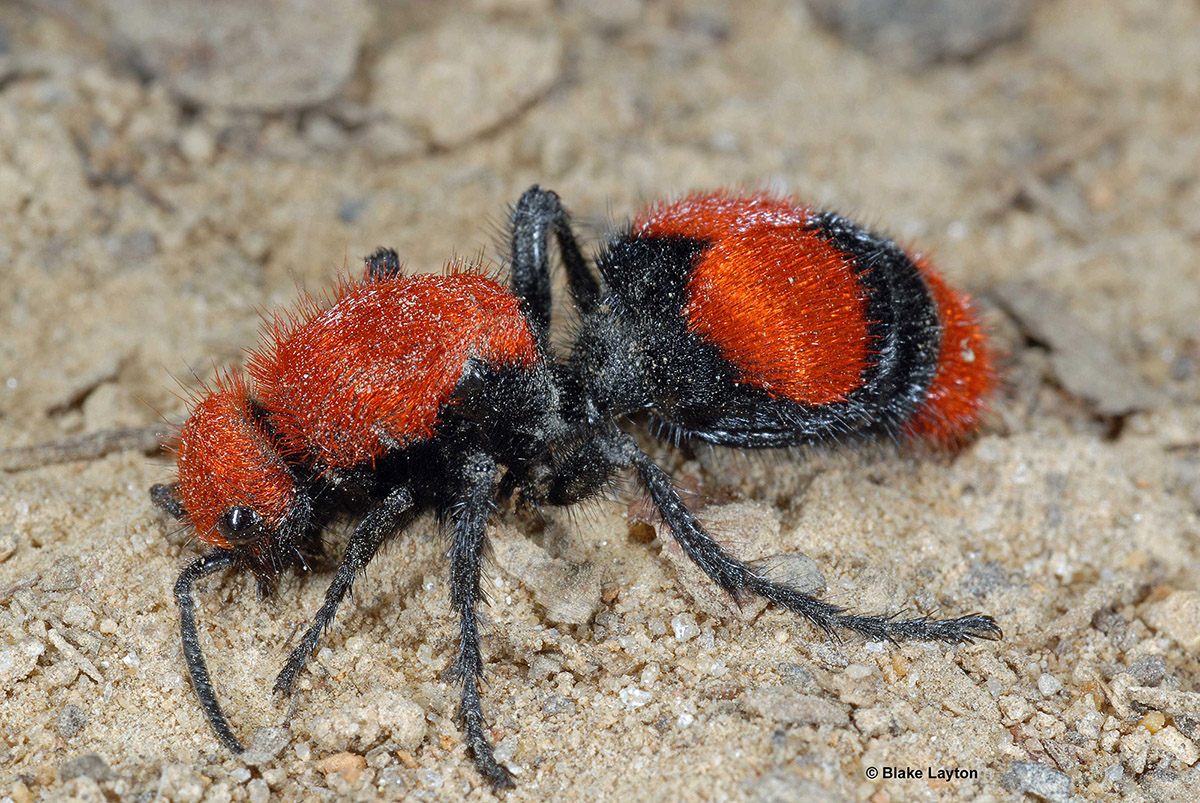Eastern Velvet Ant, Vol. 5, No. 22

Dasymutila occidentalis
Order: Hymenoptera
Family: Mutillidae
Despite the name this “ain’t no ant;” it is a wingless wasp. But only the females are wingless; the males have wings. There are quite a few species of mutillid wasps in the state, but the Eastern velvet ant is the largest and most often seen.
Red and black coloring often signals danger in nature, “I can hurt you; leave me alone,” and this is definitely the case with velvet ants. Females are up to one inch long with an average stinger length of just over ½ inch. People who have been stung by an Eastern velvet ant say it has the most painful sting of any insect in the Southeast—more painful than a red wasp. Most southerners call these cow killer ants, and most folks who have experienced a sting feel this name is most appropriate. Fortunately, velvet ants are not aggressive, and stings are rare. They only sting when stepped on with bare feet, sat on, rolled on while playing in the grass, or improperly handled.
Female velvet ants are often seen this time of year as they scurry over the ground in search of cicada killer wasp nests or nest of other large ground-nesting wasps. Cicada killers, which are the largest wasps in the South, nest in burrows in the soil, which they provision with one to three paralyzed cicadas before depositing an egg. The hatching cicada killer larva feeds on these cicadas and develops to the pupal stage, remaining in the burrow to emerge as an adult the following year. That is unless it is parasitized by an Eastern velvet ant; then it is an adult velvet ant that emerges from the burrow the following year.
Consider the sequence of events here. Cicadas emerge and begin singing in the trees, cicada killer wasps emerge and start hunting cicadas, and eastern velvet ants emerge to search for cicada killer nests. What hunts the velvet ants? Not much. These are tough, essentially predator-proof insects. Not only do they have that long, painful sting, but their abdomen is unusually flexible, allowing them to wield this sting very skillfully. They also produce a repellent defense secretion and make a loud stridulating sound when molested. Finally, these are unusually tough, hard-bodied insects, as anyone who has ever tried to crush one of these by stepping on it can confirm. Any predator that attempts to eat a velvet ant quickly learns this is not a good idea, and this explains why these brightly colored insects are able to move about so conspicuously and fearlessly during the day time.
See Bug’s Eye View No. 21 of 2017 for information on cicada killer wasps.
http://extension.msstate.edu/
See Bug’s Eye View No. 14 of 2015 for information on annual cicadas.
http://extension.msstate.edu/
Blake Layton, Extension Entomology Specialist, Mississippi State University Extension Service. The information given here is for educational purposes only. Always read and follow current label directions. Specific commercial products are mentioned as examples only and reference to specific products or trade names is made with the understanding that no discrimination is intended to other products that may also be suitable and appropriately labeled.
Mississippi State University is an equal opportunity institution.

